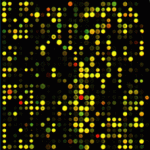Genomics
|
25 april 2012 17:00:25 |
| The Physalis peruviana leaf transcriptome: assembly, annotation and gene model prediction (BMC Genomics) |
|
Tweet Background:
Physalis peruviana commonly known as Cape gooseberry is a member of the Solanaceae family that has an increasing popularity due to its nutritional and medicinal values. A broad range of genomic tools is available for other Solanaceae, including tomato and potato. However, limited genomic resources are currently available for Cape gooseberry.
Results:
We report the generation of a total of 652,614 P. peruviana Expressed Sequence Tags (ESTs), using 454 GS FLX Titanium technology. ESTs, with an average length of 371 bp, were obtained from a normalized leaf cDNA library prepared using a Colombian commercial variety. De novo assembling was performed to generate a collection of 24,014 isotigs and 110,921 singletons, with an average length of 1,638 bp and 354 bp, respectively. Functional annotation was performed using NCBI`s BLAST tools and Blast2GO, which identified putative functions for 21,191 assembled sequences, including gene families involved in all the major biological processes and molecular functions as well as defense response and amino acid metabolism pathways. Gene model predictions in P. peruviana were obtained by using the genomes of Solanum lycopersicum (tomato) and Solanum tuberosum (potato). We predict 9,436 P. peruviana sequences with multiple-exon models and conserved intron positions with respect to the potato and tomato genomes. Additionally, to study species diversity we developed 5,971 SSR markers from assembled ESTs.
Conclusions:
We present the first comprehensive analysis of the Physalis peruviana leaf transcriptome, which will provide valuable resources for development of genetic tools in the species. Assembled transcripts with gene models could serve as potential candidates for marker discovery with a variety of applications including: functional diversity, conservation and improvement to increase productivity and fruit quality. P. peruviana was estimated to be phylogenetically branched out before the divergence of five other Solanaceae family members, S. lycopersicum, S. tuberosum, Capsicum spp, S. melongena and Petunia spp. |
| 119 viewsCategory: Genomics |
 Functional organization and its implication in evolution of the human protein-protein interaction network (BMC Genomics) Functional organization and its implication in evolution of the human protein-protein interaction network (BMC Genomics)Enhancer identification in mouse embryonic stem cells using integrative modeling of chromatin and genomic features (BMC Genomics) 
|
| blog comments powered by Disqus |
MyJournals.org
The latest issues of all your favorite science journals on one page
The latest issues of all your favorite science journals on one page



